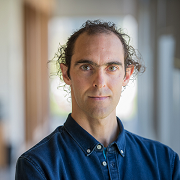
Abstract
During embryogenesis, genetically encoded instructions drive sophisticated arrangements of cell types in time and space. Efforts are underway to control cellular arrangements in vitro, among those organoids and tissue engineering, with the goal of developing next generation platforms for drug discovery and disease modeling. More recently, artificial genetic networks have been used to control cell behaviors. We and others have been using artificial genetic networks towards designing cellular arrangements. I present here developments from our lab of two novel approaches. (1) To control differentiation in space, we combined synthetic signaling pathway engineering, with patterns of synthetic ligands presented from a material. We developed three ways to present synthetic ligands (e.g. GFP): microcontact printing in 2D; hydrogel engineering and click chemistry in 3D; we genetically engineer cells to produce ECM proteins with embedded synthetic ligands (e.g. fibronectin-GFP fusions). With these setups, we first show the capacity and limits of these different technologies to spatially and temporally activate reporter genes in engineered cells in user-defined spatial patterns of 2 different ligands. We then use dual-ligand patterning to control transdifferentiation of a composite tissue where endothelial precursors, fibroblasts and skeletal precursors are differentiated in user-specified geometries. This approach is modular and could be used with other cell types both in 2D and 3D. (2) We use artificial pathways (with no material components) to encode patterning and morphogenesis with synNotch-based intercellular transcriptional networks. To aid with the design of these networks we developed a computational framework that allows us to explore a large parameter space range. When implemented in cells, these networks can affect cell behaviors (proliferation, adhesion, "fluidity" and ultimately differentiation) in spatially and temporally controlled fashion. Cells engineered with these networks can self-organize not only in patterned spheroid, but also in self-elongating structures. Collectively, our work contributes towards desinging complex tissue self-organization, which will complement our understanding of self-organization design rules and allow us to deploy new technologies for controlling stem cells in vitro for the regenerative medicine applications.


